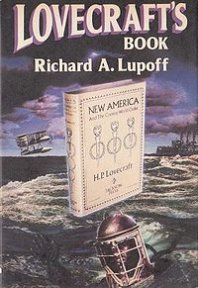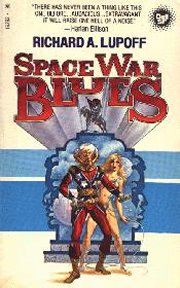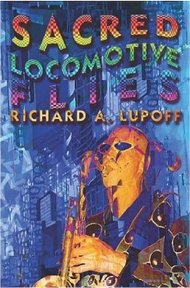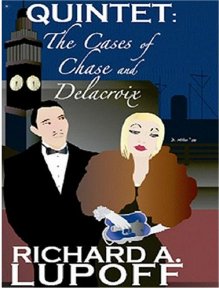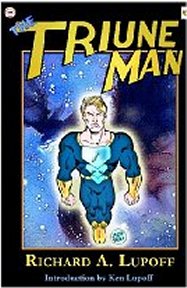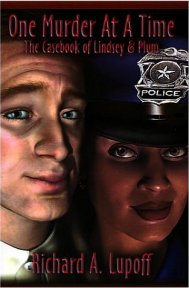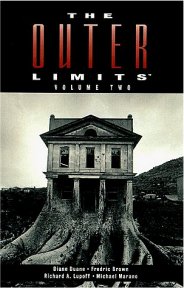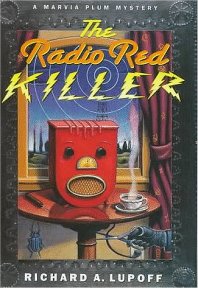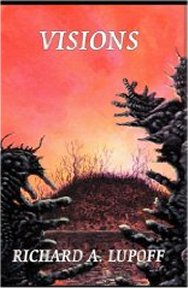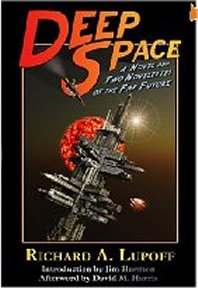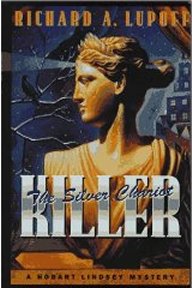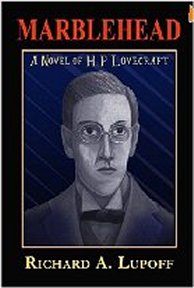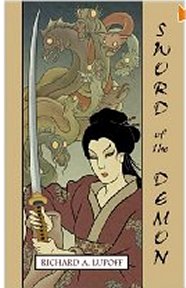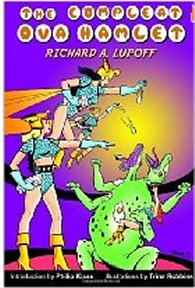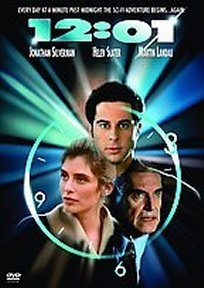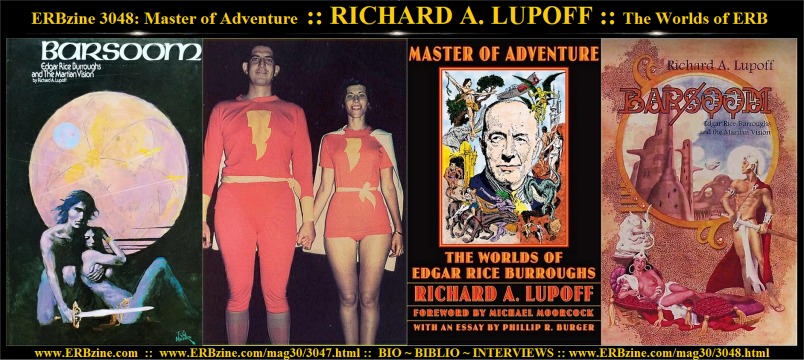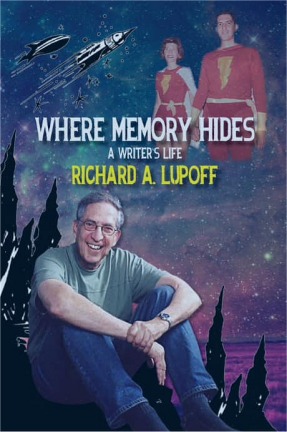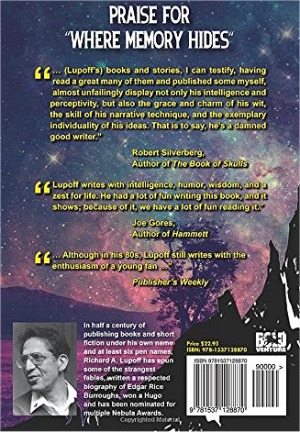SF
Recollections
by Richard Lupoff
Pat and Dick Lupoff
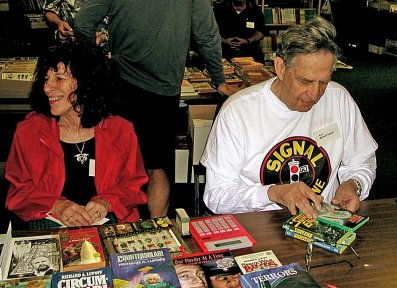 One
of my earliest recollections is of crouching on the living room rug, peering
over my brother's shoulder as he read the Sunday funnies. Of all the features,
I most vividly remember Flash Gordon. The splendid men and gorgeous women,
all in their form-fitting costumes... the Art Deco cities with their graceful,
sweeping vistas and their soaring towers... and of course the beautifully
rendered spaceships and Alex Raymond's dazzling imagery of outer space...
One
of my earliest recollections is of crouching on the living room rug, peering
over my brother's shoulder as he read the Sunday funnies. Of all the features,
I most vividly remember Flash Gordon. The splendid men and gorgeous women,
all in their form-fitting costumes... the Art Deco cities with their graceful,
sweeping vistas and their soaring towers... and of course the beautifully
rendered spaceships and Alex Raymond's dazzling imagery of outer space...
But there was something missing. There were those little
black marks that I knew were words. They were the words that told the story
and they were the words that were being spoken by those splendid people.
And Jerry could read them (he was three years older than I) and I could
not.
If ever anyone was driven mad by lust, I think I was.
Made mad or very close to it by the lust to read. I went on a campaign,
demanding ceaselessly to be taught to read. I was told that I would learn
when I started school, three years after my brother. I could not wait.
I must have driven the rest of the household close to madness, too, until
my wonderful Austrian-born grandmother yielded to my pleas and taught me
to read.
I recall the event with great vividness. It was a lovely,
sunny day, the household was (relatively tranquil), and we sat down after
lunch and Grandma simply showed me the letters and told me their sounds
and explained that they went together and made words. That was all. By
dinner-time I could read.
People have told me that this is impossible, that my memory
must be grossly distorted if not outright false. But others have told me
that they had the same experience -- a pent-up desire to learn to read,
a kindly mentor willing to show them how -- and it is done.
Once I had learned to read, I proceeded to devour every
piece of writing I could lay my hands on. But two more overwhelming discoveries
lay
ahead. At first, those endless books and newspapers and magazines and comics
were a given. They were simply there. But one day I realized that they
were not simply there: somebody wrote them. And another day I realized
that I could write them.
I remember my earliest efforts at creation. I wrote and
drew a book called An Adventure. This consisted of simple scenes
of a young boy visiting famous sites. The Stach You of Liberty and the
White House are two that I remember. The young boy was chubby, had masses
of curly dark hair, and wore only a swimming suit.
A while later I was a contestant in a round-robin storytelling
contest. Terrified of disgracing myself and causing my team to lose the
contest, I won us a bonus point for my chapter about a haunted house. What
a surge of adrenaline the judges' announcement provoked -- I've never tried
heroin but I can't imagine any chemical more addictive than adrenaline.
I was hooked for life.
These events took place in the late 1930s and early '40s
-- I was born in 1935 -- and as you'd expect, my strongest subjects in
school were literature and composition, followed by history. I did all
right in the physical sciences and was a disaster in math.
By 1949 or '50 I was earning pocket money as a stringer
for metropolitan newspapers, filing stories on prep school sports. There
I was, all of 14 years old, on the sports pages of the New York Times and
Herald-Tribune, the Philadelphia Inquirer and Bulletin. More intoxication.
My stories tended to be one paragraph -- sometimes one sentence -- in length,
except for the longer, bylined pieces in the local weekly, the Bordentown,
New Jersey, Register. But in the big dailies, my copy ran cheek-by-jowl
with the works of Stanley Woodward and Red Smith and Jimmy Cannon, the
greatest sports writers of their generation.
In college I wrote for the Coral Gables, Florida, Times,
and for the 6:00 o'clock news five days a week at WIOD, Miami, owned by
the Wonderful Isle of Dreams Broadcasting Company. It was pretty heady
stuff for a 19- or 20-year-old to finish his last class of the day, head
down to the studio, get on the phone and talk to judges and mayors and
police chiefs. I used to finish my work by 5:55, turn in my copy to Gene
Struhl, the news director, then get in my car and listen to my stuff as
I drove home for dinner. Once in a while I'd stay at the station to keep
tabs on a late-breaking story, and sneak into the studio with update copy
while either Struhl or one of our staff announcers was on the air. It was
like living in a movie.
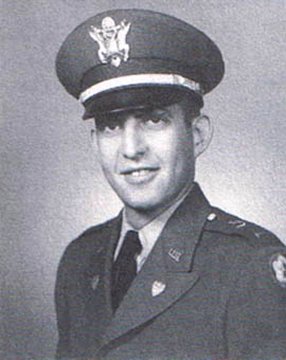 We're
talking about the Eisenhower Era now, and in those Cold War days part of
every young man's life (or nearly everyone's) was a tour in uniform. I
have no military horror stories to tell. The Korean War was over, we weren't
fighting yet in Viet Nam, and I spent two fairly comfortable years variously
at Fort Benning and Fort Gordon, Georgia, and Fort Benjamin Harrison, Indiana.
Hey, I can still sing our informal class anthem at the Infantry School:
We're
talking about the Eisenhower Era now, and in those Cold War days part of
every young man's life (or nearly everyone's) was a tour in uniform. I
have no military horror stories to tell. The Korean War was over, we weren't
fighting yet in Viet Nam, and I spent two fairly comfortable years variously
at Fort Benning and Fort Gordon, Georgia, and Fort Benjamin Harrison, Indiana.
Hey, I can still sing our informal class anthem at the Infantry School:
High above the Chattahoochee
Near the Upatois
Stands our dear old alma mater
Benning School for Boys....
But I didn't see myself as a career soldier, and in 1958
I packed my uniform away and started looking for a job as a writer or editor.
I think I would have loved working for John Campbell or Anthony Boucher
or Horace Gold as an assistant at one of the science fiction magazines
of the day, but instead I fell into a job as a technical writer for what
was then Sperry Univac.
We tech writers were considered junior executives, suit-and-tie
types, and the starting salary was $350 a month. Of course the first thing
I did was get married. Fortunately, in 1958 it was possible for a young
couple to lead a very pleasant upper-middle-class life on that salary.
In that job I got my first look at a computer. Univac
I. It had 1000
words of memory, roughly the equivalent of 12K bytes.
The storage medium was a mercury delay line, and if you wanted to look
at the memory you had to open a door in the side of a garage-sized metal
structure and walk inside. It held half-a-dozen people comfortably.
Wow!
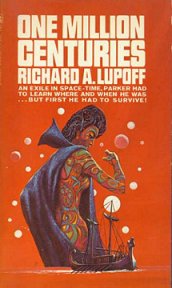 I
worked for Sperry for five years, then for IBM for seven. The last few
years of my IBM tour were spent writing and directing movies. It was a
good job and IBM was a great employer, but this was just not what I wanted
to do with my life. I wanted to write books. I wrote my first book, Edgar
Rice Burroughs: Master of Adventure, in 1965, and my first novel, One
Million Centuries, in 1967.
I
worked for Sperry for five years, then for IBM for seven. The last few
years of my IBM tour were spent writing and directing movies. It was a
good job and IBM was a great employer, but this was just not what I wanted
to do with my life. I wanted to write books. I wrote my first book, Edgar
Rice Burroughs: Master of Adventure, in 1965, and my first novel, One
Million Centuries, in 1967.
Still, I stayed with IBM until 1970, shucking my suit
and tie each evening, climbing into sweatshirt and jeans and going to work
on a novel or short story. I'd wanted to get out of the big business environment
and devote myself to writing for ten years. There was always a reason to
defer the move -- generally economic -- but with Pat's support and encouragement
I finally made the break.
It's been 25 years since then, frequently precarious ones.
Sometimes we've come close to financial disaster, but I have to believe
that the decision was right.
My first love in literature was the fantastic. I was a
passionate reader of comic books: superheroes, science fiction and horror.
I followed the same preferences when I was ready for "real" books. When
I was eight, our school librarian spotted me as a reader and tried to guide
me to good literature as she saw it. Since her taste ran heavily to nineteenth-century
French romantic writers, I was soon up to my elbows in Dumas, Hugo (admittedly,
as much a realist as a romantic), and Jules Verne.
Little did Miss Schultz realize, when she handed me a
copy of Twenty Thousand Leagues, that she was nourishing my taste
not for French romantics but for science fiction.
In the same era I picked up a wonderful little Avon paperback
horror anthology that contained "The Dunwich Horror" by H.P. Lovecraft,
"By the Waters of Babylon" by Steven Vincent Benet, and "The Yellow Wallpaper"
by Charlotte Perkins Gilman. I'm afraid those are the only stories that
I remember from The Avon Ghost Reader, but considering that I read
it almost fifty years ago, the impressions that the stories made must have
been pretty strong.
Not long after that I read two more anthologies that made
an immense impression on me: The Science Fiction Galaxy edited by
Groff Conklin and Shot in the Dark edited by Judith Merrill. By
the early 1950s I was a fanatical reader of science fiction magazines:
Galaxy, Fantasy and Science Fiction, Other Worlds, Thrilling Wonder Stories
and a couple of dozen others.
Which brings me back to college, and the army, and my
first real job and my marriage. In those early years a favorite outing
for Pat and myself began with a sleazy science fiction movie, or better
yet a double feature. Maybe, War of the Colossal Beast and House
on Haunted Hill. Tickets cost fifty cents. We lived near White Plains,
New York, for the first year of our marriage, and after the movies we would
walk to Tommy Chen's restaurant for a late dinner topped off with watery
chocolate ice cream. Then home to our apartment and our cocker spaniel.
What could be more Eisenhower American?
In 1963 I was working for IBM in the Time/Life Building
at 50th Street and Sixth Avenue. Pat and I had long since moved to Manhattan
and had a wonderful apartment on East 73rd Street. I had a second job,
moonlighting as an editor for Canaveral Press at 63 Fourth Avenue. Working
for Canaveral, I found myself acting as Edgar Rice Burroughs' posthumous
editor. After assembling a couple of volumes of Burroughs' previously
uncollected short stories and preparing several of his unpublished novels
for release, I was asked by the owners of the company, Jack Biblo and Jack
Tannen, to write a book about him.
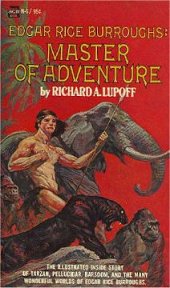
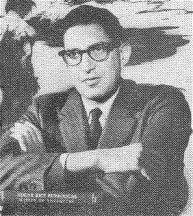
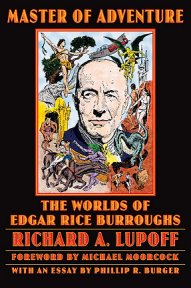
That was the genesis of Edgar Rice Burroughs: Master
of Adventure, my first book. After five more years of balancing my
work for IBM with my literary career, I gave up on the computer industry.
My manager in those last days was Fox B. Holden, a onetime pulp writer
whose stories had graced the pages of Planet Stories and Imagination in
the 1940s and '50s. I think Fox saw me as a surrogate for himself; he'd
reached the same fork in the road, years earlier, that I reached in 1970.
He felt that he'd taken the wrong path, and he was relieved to see my make
the right choice.
I concentrated on science fiction throughout the 1970s.
Most of my books were well received, and some of them achieved a degree
of commercial success although I never had a major hit. Still, I felt that
I was getting somewhere with novels like Sacred Locomotive Flies, Space
War Blues, The Triune Man, Sun's End, and Circumpolar!, as well
as my one all-out fantasy novel, Sword of the Demon. I also edited
a series of anthologies called What If? -- Stories That Should Have
Won the Hugo.
But when the Carter inflation of the late 1970s gave way
to the Reagan recession of the early '80s, my markets disappeared and financial
disaster loomed. I wound up pushing papers in the federal bureaucracy from
1982 to 1985. By the mid-1980s, however, Pat's career as a retail bookseller
was thriving, the literary market seemed to be recovering, and I decided
to sample the water again, as a novelist.
I had, after all, made a pretty good track record for
myself in my first incarnation. My books had been published by several
leading companies in the US and abroad, and my stories had been printed
in major magazines and anthologies. I'd been nominated many times for Hugo
or Nebula awards, although ironically the only time I ever won was as a
fan publisher, back in the dawn of time. Theodore Sturgeon had sung my
praises to the sky in The New York Times Book Review, and A. E. Van Vogt
had compared my impact on the quality of writing in science fiction to
that of Ray Bradbury. My works had been translated into French, German,
Hebrew, Greek, Spanish, Portuguese and Japanese.
Really, conditions seemed propitious for a second career
in science fiction, and I did get several more novels into print: The
Forever City, Countersolar!, Galaxy's End. But two of these were sequels
to earlier books; I was having trouble selling anything really new. The
lesson that I had to accept was that the field had moved on, leaving me
behind. It's painful to say this, but it was nonetheless true.
To a large extent my new books failed to generate the
excitement that they once had, among critics, academics, and fans. There
were exceptions. The Los Angeles Times Book Review ran a front-page rave
of Countersolar! by Orson Scott Card, and I received friendly notices
from other critics in The Washington Post and the Bloomsbury Review. But
I couldn't get the deals I wanted with the publishers I wanted to sell
to, and the more vociferous fans had gone on to new heroes.
And then I received the same piece of advice from three
sources whom I respected. These were my wife, Pat, who knew the book business
from the retail end... my agent, Henry Morrison, who knew it from the publishing
end... and my longtime friend Noreen Shaw, a librarian in the Los Angeles
public library system. They all said, "Write a mystery."
This wasn't altogether an alien idea to me. One of my
earliest stories, written for a mimeographed newspaper at summer camp,
had been a private eye yarn. One of my science fiction novels, The Triune
Man, was really as much murder mystery as it was science fiction. And
I'd done a fairly successful spy thriller featuring one of my boyhood idols
in an (imaginary) "real-life" adventure: Lovecraft's Book.
So I gave it a shot, and wrote The Comic Book Killer,
featuring the detective team of insurance investigator Hobart Lindsey and
Berkeley police officer Marvia Plum. That was followed by The Classic
Car Killer,
The Bessie Blue Killer, The Sepia Siren Killer,
and The Cover Girl Killer.
I've also done some teaching at the University of California
and elsewhere, run a weekly talk show on KPFA in Berkeley for many years,
and had a few, generally painful, dealings with Hollywood. A brilliant
young filmmaker named Jonathan Heap made a superb 30-minute version of
my short story 12:01 PM. It was an Oscar nominee in 1990, and was
later adapted (very loosely) into a two-hour Fox movie called 12:01.
If you happen to see the two films, you might want to
try and spot the only actor who appears in both -- me, as an extra. Possibly
the most obscure piece of Hollywood trivia of all time.
The story was also adapted -- actually plagiarized --
into a major theatrical film in 1993. Jonathan Heap and I were outraged
and tried very hard to go after the rascals who had robbed us, but alas,
the Hollywood establishment closed ranks. We were no Art Buchwald. After
half a year of lawyers' conferences and emotional stress, we agreed to
put the matter behind us and get on with our lives.
I am frequently asked why I quit science fiction, and
when or whether I will ever return to it. The fact is, I didn't quit, I
was fired. When I returned to the field after my forced, temporary retirement
of the early 1980s, the earlier interest that readers and editors had shown
in my work was no longer present. My grand project, a massive work called
Born
of the Stars, exists as a lengthy, detailed synopsis. Several publishers
have considered it, but only one saw fit to offer me a contract. And in
that case, the price offered was an affront and the terms and conditions
of publication showed the publisher's attitude clearly: I was supplying
yard goods. I had my agent return the contract unsigned.
There's another volume to be written in each of my science
fiction series. Those would be Time's End and Transtemporal!
I've got a wonderful little time-chase novel called Emperor of Yesterday.
Those three books, plus Born of the Stars, represent several years'
work. All of these books exist as sketches, outlines, synopses, or rough
notes... in my file cabinet, on my computer's hard disk, or just in my
brain. Sure, I'd be willing to write any or all of them -- if I were offered
a decent contract and an adequate price. Otherwise -- pardon the melodramatics,
but this happens to be simple truth -- they will go to the grave with me.
I did have many wonderful friends and colleagues in the
science fiction field. My first mentor, James Blish, who heard my tale
of frustration as an unsuccessful short story writer and offered the obvious
(but for some reason not obvious to me) solution: write a novel. The editor
who bought my first novel, Larry Shaw, and who remained a friend for life.
Other editors I worked with and respected and liked: Don Bensen, David
Hartwell, the brilliant David Harris, Robert Silverberg (as talented a
teacher and critic as he is a writer), Victoria Schochett, Terry Carr,
Maxim Jakubowski, Nick Austin, Marcial Souto. Good friends like Tom Disch
and Chip Delany and Sam Moskowitz with whom I once feuded but later came
to appreciate. Older writers who were endlessly kind and generous to a
beginner: Edward Elmer Smith, Edmond Hamilton, Leigh Brackett, Jack Williamson,
Robert Heinlein, Jack Vance, Poul Anderson. I'm afraid of leaving someone
out and suffering remorse when it's too late to add to this list.
I have walked with giants.
Incidents emerge from memory like gems from the dust...
One evening in 1962 or so, Don and Elsie Wollheim and
Pat and I were walking on a quiet street in Manhattan. Don put his hand
on my arm and pointed up at the dark sky. Among the unmoving stars, one
brilliant point of light made a brilliant arc, then disappeared.
"Do you know what that is?" Don asked.
"It's a Soviet satellite," I replied. I read my New York
Times every morning, and knew what was in orbit as well as the next fellow.
Wollheim shook his head. "That's a spaceship, and there's
a spaceman in it."
We have eyes, but do not see.
I remembered standing on a grassy lawn in Florida in 1956,
looking at the sky, and hoping that I would live a long life, because someday...
maybe as early as the first decade of the 21st Century...humans might walk
on the moon. And we did, not in 2009 but in 1969.
And a quarter century later, I met and shook hands with
Alan Shepard, who walked on the moon, and played golf there. I walked down
Telegraph Avenue in Berkeley with Shepard, acting tacitly as a bodyguard
because the street is dangerous at night. Then I gave him highway directions,
and urged him to drive carefully because California was having its first
rainstorm of the season and the streets would be slippery.
And I thought, afterwards, that moment was passing strange.
Stranger still, and tragic, that a quarter century after we reached the
moon, we have lost our vision and our commitment to go out to the wonder-filled
universe, and are more intent, instead, on killing each other off with
bullets and pollution and overpopulation.
My writing nowadays is devoted mainly to the crime-and-detection
field, and I remind you again, I did not quit science fiction, I was fired.
I make occasional forays into fantasy, whimsy, or mainstream fiction. I've
never done a mainstream novel, but I've tried it in shorter lengths with
some success and considerable pleasure. One of these days I may just hitch
up my britches, spit on my hands, and give that book a try. But I still
write some shorter science fiction pieces. The major one at hand is of
course "Black Mist."
And if you will excuse me now, I have work to do -- on
my next mystery novel.
Richard A. Lupoff
January, 1995

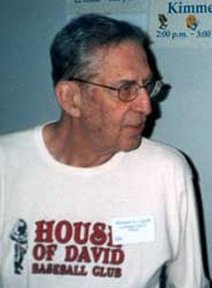
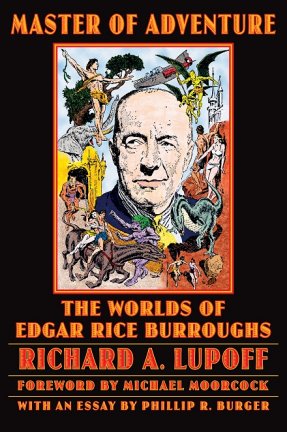
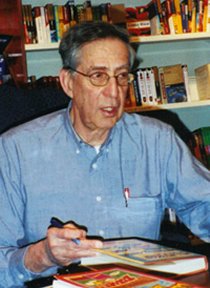

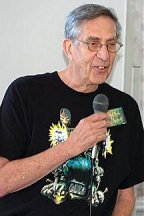 Richard
A. Lupoff, the respected critic and writer who helped spark a Burroughs
revival in the 1960s, reveals fascinating details about the stories written
by the creator of Tarzan. Featured here are outlines of all of Burroughs's
major novels, with descriptions of how they were each written and their
respective sources of inspiration. This Bison Books edition includes a
new foreword by fantasy writer Michael Moorcock, a new introduction by
the author, a final chapter by Phillip R. Burger, as well as corrected
text and an updated bibliography.
Richard
A. Lupoff, the respected critic and writer who helped spark a Burroughs
revival in the 1960s, reveals fascinating details about the stories written
by the creator of Tarzan. Featured here are outlines of all of Burroughs's
major novels, with descriptions of how they were each written and their
respective sources of inspiration. This Bison Books edition includes a
new foreword by fantasy writer Michael Moorcock, a new introduction by
the author, a final chapter by Phillip R. Burger, as well as corrected
text and an updated bibliography.
 One
of my earliest recollections is of crouching on the living room rug, peering
over my brother's shoulder as he read the Sunday funnies. Of all the features,
I most vividly remember Flash Gordon. The splendid men and gorgeous women,
all in their form-fitting costumes... the Art Deco cities with their graceful,
sweeping vistas and their soaring towers... and of course the beautifully
rendered spaceships and Alex Raymond's dazzling imagery of outer space...
One
of my earliest recollections is of crouching on the living room rug, peering
over my brother's shoulder as he read the Sunday funnies. Of all the features,
I most vividly remember Flash Gordon. The splendid men and gorgeous women,
all in their form-fitting costumes... the Art Deco cities with their graceful,
sweeping vistas and their soaring towers... and of course the beautifully
rendered spaceships and Alex Raymond's dazzling imagery of outer space...
 We're
talking about the Eisenhower Era now, and in those Cold War days part of
every young man's life (or nearly everyone's) was a tour in uniform. I
have no military horror stories to tell. The Korean War was over, we weren't
fighting yet in Viet Nam, and I spent two fairly comfortable years variously
at Fort Benning and Fort Gordon, Georgia, and Fort Benjamin Harrison, Indiana.
Hey, I can still sing our informal class anthem at the Infantry School:
We're
talking about the Eisenhower Era now, and in those Cold War days part of
every young man's life (or nearly everyone's) was a tour in uniform. I
have no military horror stories to tell. The Korean War was over, we weren't
fighting yet in Viet Nam, and I spent two fairly comfortable years variously
at Fort Benning and Fort Gordon, Georgia, and Fort Benjamin Harrison, Indiana.
Hey, I can still sing our informal class anthem at the Infantry School:
 I
worked for Sperry for five years, then for IBM for seven. The last few
years of my IBM tour were spent writing and directing movies. It was a
good job and IBM was a great employer, but this was just not what I wanted
to do with my life. I wanted to write books. I wrote my first book, Edgar
Rice Burroughs: Master of Adventure, in 1965, and my first novel, One
Million Centuries, in 1967.
I
worked for Sperry for five years, then for IBM for seven. The last few
years of my IBM tour were spent writing and directing movies. It was a
good job and IBM was a great employer, but this was just not what I wanted
to do with my life. I wanted to write books. I wrote my first book, Edgar
Rice Burroughs: Master of Adventure, in 1965, and my first novel, One
Million Centuries, in 1967.



